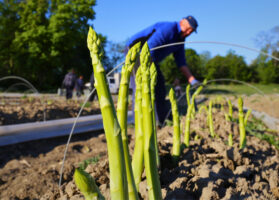Good weather providing a boost for crop of Southeast berries
Overview of blueberries in the U.S. market, complemented by charts from Agronometrics. Original published on February 21, 2023.
Southeast berry grower-shippers say they should have a decent-size crop of good-quality blueberries and blackberries this spring as long as the weather remains favorable.
After the company’s citrus crop endured two hurricanes and a freeze, Florida Classic Growers, Dundee, Fla., is looking forward to a new crop of blueberries, said Sales Manager Darrell Congdon.
“We’re looking for something good, new and normal,” he said. The company is primarily a citrus shipper but added blueberries and peaches to its product line about 10 years ago.
Florida Classic Growers produces four kinds of blueberries in the Polk County region in the central part of the state. Some varieties kick off early, while others come on later in the season, providing the company with berries from mid-March until around early May.
“There’s always a new crop coming,” Congdon said. The weather has been perfect so far this year, he said, unlike last year when a late freeze affected blueberries and peaches.
“If the weather holds, we’ll have a great crop,” he said, noting a volume similar to last year.
Miami-based Crystal Valley Foods also anticipates a good crop of blueberries and blackberries this season, said Katiana Valdes, marketing director. The company sources its Southeast berries from Alabama and Georgia. Southeast blueberries will start shipping at the beginning of April, and blackberries will get underway in June, same as in 2022.

Source: USDA Market News via Agronometrics.
(Agronometrics users can view this chart with live updates here)
“For Georgia and Alabama, the average size is about 12 millimeters (about half an inch) and up,” she said. “On our blackberries from Georgia, we expect good sizing on all varieties.”
Crystal Valley Foods expects to have increased volume on Southeast blueberries compared to last year, and blackberry volume should be about the same as previous years, she said.
Harvesting of Florida, Georgia and North Carolina Southeast blueberries and blackberries from Salinas, Calif.-based Naturipe Farms will be delayed a bit this season, said Brian Bocock, vice president of product management.
“So far it has been wetter and cooler,” he said. And Florida was impacted by Hurricane Ian.
However, the crop is shaping up to be of “good quality and good volume,” he said. “We expect that the crop will be up compared to last year, as we previously had significant damage in Georgia.”
He was especially proud of the company’s Southern Grace proprietary blackberry variety.
“It’s a fantastic piece of fruit,” Bocock said. The company also grows organic blueberries in Florida and Georgia.
All Southeast berry grower-shippers are enduring high inflation.
Prices have gone up for labor, packing materials and other necessities for producing berries and other crops, Congdon of Florida Classic Growers said. “Every item that we put into it has gone up.”
Increased costs must be passed along, but most customers are understanding, he said.
“They’re going through the same things as we are,” Congdon said. “They have to raise their price as well to account for their increases and their expenses.”
Congdon thinks inflation might be leveling off somewhat, at least in the area of transportation.
“Transportation costs seem to fall with gas prices,” he said.
“Growers have been directly impacted by increasing costs of fuel, inputs, labor, etc.,” said Valdes of Crystal Valley Foods. “We have seen an uptick in prices across the supply chain because of this.”
Bocock said Naturipe, like others in the industry, “is feeling the impact of inflation on growers, all the way to consumers.”
“As a result of the cost increases to growing, harvesting and packing the crop, we’ve had to pass the cost increase on to our customers and consumers,” he said.
But consumers continue to buy Naturipe berries, even at higher prices, Bocock added.
The cost of labor has had a significant impact on growers’ bottom line, he said. Availability of workers also is an issue.
“We are working hard to have adequate labor,” he said.
The News in Charts is a collection of stories from the industry complemented by charts from Agronometrics to help better tell their story.
Access the original article with this (Link)






